#If you're not from one of those Eastern cultures
Explore tagged Tumblr posts
Text
The lifting the lore does in glazing when none of the demigods are actually all that powerful is so funny. In fact, neither is Queen Marika.
When GRRM said, "I wrote these guys to be normal humans a long time pre-canon," he wasn't kidding.
Marika, all-consumingly powerful, can rewrite reality with the reality rewriting macguffin! Except where she can't rewrite her children AND herself not to be cursed, and can only just barely seal a couple of Outer Gods and not actually kill them. Where she can't just write the Hornsent or the Crucible out of existence, and instead has to sacrifice people for a miserable, honorless war. Turns out, she's just an average, rote god, but she has propaganda on her side, and maybe a slight homefield advantage. But she isn't special and never has been.
Radahn, mightiest demigod of the Shattering! Who got his ass kicked by some sewer-scented old man with a walking stick. Twice. Plus he couldn't properly siege Stormveil Castle. So his official score in "notable battles" is 1/3/1. That's a championship record if I've ever seen one, truly worthy of the "mightiest" title.
Malenia, the undefeated!!!! Because she had to throw her pride away just to *tie* the dude that got his ass kicked by a stinky geriatric, when she was actively trying to kill him. Sure, Caelid is a mess now, but all she did was slap an aeonia down; the scarlet aeonia and the rot itself propagated under its own power, she wasn't controlling it once it was unleashed.
Morgott: should therefore be as powerful or more than both of the above, but is a midgame boss, and not even a particularly difficult kill, with no particular skills other than a little holy magic, so who knows how he even got Radahn in the first place. Except if Radahn isn't actually as powerful as the glazing tells you he is, and therefore neither is Malenia.
And all of the above can get absolutely humbled by some naked dude with a stick.
I could also go on about how Miquella's plan makes a ton more sense if you take away the bullshit anime superpowers, but bullshit anime superpowers is what makes the video game a video game, so they gotta stay.
PS: "Prime Radahn" isn't actually that powerful; if his fight was only phase 1, he would be easier than Malenia, even before the nerfs. He is buffed by Miquella to be as punishing as he is in Phase 2 - You're not fighting "Prime Radahn" acting under his own power, you're fighting "Prime Radahn" with a pocket buff machine enhancing his abilities; it's the combined strength of Miquella and Radahn, actively trying to defeat you... and you STILL win.
But this is a poignant point about the way FromSoft makes their characters: Even in their "prime", they are still defeatable by a naked dude with a stick. Even in their "prime", they're not all-powerful. It's for the same reason FS never writes people in positions of power as unambiguously good: You are supposed to realize how falliable those in power are. You are supposed to question them, their intentions, and see through the illusion and transience of their "power". GRRM wrote the characters even weaker and more falliable than FS would, it seems, but even "buffed" - just like Radahn - they are still people, and just as susceptible to the faults that come with that.
#elden ring#starscourge radahn#malenia blade of miquella#morgott the omen king#there's a decent video I watched a while ago called “Why Do You Always Kill Gods in JRPGs?”#by Moon Channel#that points out how in a lot of Eastern cultures especially#gods are transient beings that can come from basically anything or anywhere#but just as one can rise to godhood#one can fall from it just as easily and become a mortal or even an evil presence#understanding how eastern cultures view deities could actually help a lot of people trying to analyze Elden Ring#understand a lot about how to interpret the story#It's using Western tropes a lot yes#but viewed through an extremely Eastern lens#If you're not from one of those Eastern cultures#just develop an unhealthy obsession with a media that is unapolagetically steeped in especially Japanese mythology and history#you'll gain even more Insight points analyzing Soulsborne afterward#I promise#(Mine was Touhou but I don't recommend that one for a myriad of reasons)
46 notes
·
View notes
Text
Raise your hand if you want elaborate Hatake warring states drama set maybe 40-50 years before Konoha was founded to help explain/elaborate on the start of the Hatake's downfall + provide cultural context for why they value their children so much !!!
Just kidding !! You're getting it anyways !!
Ok, so.
The Hatake's used to be made up of several small packs, ranging in sizes from 20-40 people, with a couple especially large or small packs here and there, as well as a few individual wanderers. But there were a good number of packs all together, so their overall numbers were like, a good few hundred.
Each pack was nicknamed after a part of a wolf + a direction. "The western fang", "the southern tail" (not to be confused with the eastern tail) "the northern paw", etc. The joke there was that together, they all make one wolf
Packs also had individual heads— there was no one overall singular clan head of all the Hatake, and they mostly operated independently of each other, but (most) would try and keep in contact to sure they at least remained on the same general page (they did have a few outliers, and honestly a lot of packs were just kind of... bad at keeping in contact. Some packs were much closer than others, while others were much more distant)
Whenever they needed to do any sort of political maneuvering, they'd converge, and the individual pack heads would choose a spokesman to represent them for the specific matter.
But about 40 years ago, just around when Hatake Haruka was born, there was a very sharp decline in numbers. The problem? Well, there were a few of them, but one very big specific one: They were being targeted by bloodline hunters. Hard.
So basically, fun story, there was this group of bloodline hunters specifically invested in wild clans. They'd try to kill as many as they can (to drive up scarcity) and capture any they deemed as 'tamable' that they'd then lock up and try and beat into submission in a facility nicknamed by those trapped there as the dog pound.
( This also relates to my previous talk about like. The fetishization of shinobi, particularly wild clans, and how they're often viewed as a status symbol. The wilder/more dangerous of a reputation they/their clan has, the more impressive it is for someone to have control over them )
So anyways like. The Hatake were very much on the list of targeted shinobi clans.
Also on the list were the Orochi, actually, which is also part of why, by the time konoha came around, there were only 3 left willing to step out into the sun. (There may have been more somewhere out there, but they'd refused to leave their hiding places)
Other targeted clans included the Hoshigaki, Inuzuka, and a couple other unnamed more "animalistic" clans that would be virtually extinct by the time of modern Naruto (in large part because of this entire mess, actually)
The Hatake's were the hunters primary target though and made up the majority of those they'd captured / killed.
The Hatake's nature to wander was used against them, as packs were systematically picked off— the bloodline hunters already had several stolen shinobi among them, as well as very powerful backing from some political powers which helped to feed and arm them well.
The packs would only communicate with each other so often, with some packs being more isolated than others, so it actually took a little while for some of them to actually realize what was happening— which meant even that more of them were taken by surprise
By the time Haruka was around 10, her pack (the western fang) had been very thoroughly picked through, and were down most of their shinobi.
They ended up making the very dangerous treck across Iron, continuing to be picked at every step of the way, in an effort to unite with the southern fang, which had already picked up several other stragglers, and merge into one pack
(At the time, most of the remaining packs were doing something similar— scrambling to try and merge, to try and gain some sort of power in numbers. Very few managed to make it)
At some point in all this mess, young Haruka herself actually ended up falling victim to the bloodline hunters, getting tossed into the pound. She'd be stuck there for some years, and ultimately her position inside of it would help the Hatake's destroy the dog pound once and for all.
The battle that did it in for the pound was a big one. Lots of blood, lots of fire, lots of death and destruction, all that good stuff. Everyone involved in the attack (and the Hatake were not alone in the battle, there were multiple other clans invested in seeing these bastards put down for good) was out to turn the entire place into a crater of dust.
In the end, there were no survivors on the bloodline hunters side. The pound was absolutely demolished, and it's safe to say that any remaining bloodline hunters in the area got the message loud and clear: "Don't fucking steal blood from the Hatake."
—but it also killed... a lot of Hatake. A lot, a lot. The entire events of the past couple decades did.
Afterwords, a lot of effort was put into keeping quiet on exactly what had gone down within the pound and how bad things had become for multiple clans involved in the whole debacle. In general, unless the clan was directly involved in the matter, few people— shinobi or otherwise —knew all he details of their little war.
After all, no clan wanted to be perceived as weak or vulnerable
So then Haruka becomes head of her pack somewhere in her 20s. But by that point there's like. 2 actual "packs" left, and maybe a sparce handful of individual Hatake's. And their numbers are just really low and they're having a hard time with birthing in general, so their numbers continue to be whittled down with each passing year.
It's also very important to note that this whole mess is also part why the Hatake's are so violently private.
While it was a known fact that the clan had taken a hit, no one actually knows how great of a blow they'd taken, or how many Hatake are left.
And no Hatake is willing to give that game up, because the number? Well, it's lower than any of the estimates other clans have made. They are actively dying and terrified that anyone will find out and try to once again use their isolation and numbers against them
They're trying very, very hard to hide it, and the big show of strength they flexed in that big final battle totally helped to cover their asses
By the time Konoha is founded, there are only 2 Hatake packs left— Haruka's pack, which was left with only 21 Hatake; And another unnamed one, somewhere way out west, who they lost contact with years ago.
So then skipping forward some decades, to only some years before Konoha's founding.
In Here Before and After Me there's a moment where Hashirama says,
The rare few times a child had been taken, the Hatake's had kicked up such a fuss that they'd heard of the blood baths even in Fire Country. The stories reached as far as Wind country, if you asked in the right places.
^ This is actually directly referencing an event where, sometime recently (within the last 10 years of the fic, so within ~13ish years of Konoha being founded) some idiots tried to take a Hatake child.
And the Hatake, being VERY thoroughly traumatized as a collective by the events of. Everything I said above. Went absolutely scorched earth "tear their fucking hearts out and put their heads on a pike" batshit insane on them.
Just, pulling out all the stops, total slaughter. They honestly went more than a bit overboard (but also not really, all things considering)
They were NOT about to risk another dog pound situation. They did not want to risk anyone even THINKING it was safe to so much as LOOK at them wrong. They wanted to send a message to any bloodline thief who thought they were "weak" enough to pick off (again)
And, you know, I mean, it did work. So.
Anyways this entire event lasted like, a couple decades actually. Anywhere from 20 to 30 years, with a couple lulls here and there. (the hunting technically began a decade before Haruka was born, it just hit its height around her birth)
It was a very traumatic couple of decades, and left a strong lasting impact on the Hatke's as a whole, culturally.
It's a very big part of why the Hatake are so insanely protective of their young. A good few decades of being actively hunted and preyed upon, having their kids stolen, watching other clans also lose their own children— it instilled a very healthy dose of ✨ child shaped generational trauma ✨
(It also came with a few other lasting impacts and hang ups, especially within the few still living Hatake who escaped the dog pound. Of which there are (as of writing this) three)
Fun fact! The best way to get adopted by a Hatake (particularly the older ones) is to actually specifically have them rescue you from bloodline hunters, bc it activates a primal protective rage in them instilled by years of war against those bastards
The Hatake's biggest secret being their totally shitty position also makes for some fun scenes when they finally join Konoha and sort of have to expose themselves along the way. They are making the long journey across Iron and into Fire country, and because they're taking the whole clan + all of their things in proper caravan, they have to stop at every other territory to explain themselves and where they're going and why
They are getting SO many stares from just about everyone they run into
(This is the most Hatake's anyone has ever seen, but also... Doesn't it feel like there's barely any of them...? Didn't they say that they're moving the whole clan to the new ninja village? Where's the rest of them? Is there a second caravan coming soon, or...?)
Then they finally get to Konoha and its like, !!! Welcome !!! We're so excited you're here! Where... are the rest of you?
It also makes them choose to come to Konoha so much more of a Thing™ for them, because this is genuinely a hail mary "fuck it we ball" show of trust for them. They are being forced to show their full hand and reveal the secret that they've kept so carefully guarded for the past few decades— that they're dying.
(Meanwhile, Tobirama, who is one of like THE only people ever to visit the Hatake's while still being aligned to another clan is conspicuously avoiding eye contact w Hashirama, who is sending him a very alarmed ??????)
Anyways, few individual character notes:
Haruka would actually meet and become close to Hatake Maru and the Hoshigaki girl who'd one day be Tetsuo's mother in the pound. The three became friends and in the end, managed to escape only because of each other
Maru was from one of the smaller, individual 3/2 person packs, and had been training to become a samurai before captured. Being in the pound actually only strengthened his resolve to be a swordsman, and he'd often chant the core tenants of the samurai's way to try and calm/center himself
Haruka was also captured with her brother, but he would not survive the pound and died fairly early on into their residency there. Their sister, Tobirama and Hashirama's mother, was never captured and managed to escape relatively unscathed.
While all Hatake's have the chance to earn their clan stripes via leading their first hunt when around 14/15, Haruka was trapped in the dog pound at 14/15. As such, that 'first hunt' she led as an adult ended up invertedly being the attack on the pound which she helped to lead. The stripes it earned her are known as 'mountain stripes,' and are meant to symbolize an unshakable, unstoppable iron will. Deeming her an immovable force of nature, all on her own
By the time of Konoha, Haruka is actually all that remains of what was once the western fang pack. The last other member from that pack (the twins' father, actually) died to sickness the winter before Konoha was founded. She's actually decently fucked up about it but hides it incredibly well.
Uhh final thoughts:

Hatake Haruka, age 18— she got a hundred problems and bloodline hunters are 90 of em
#Im glad I got this down on paper now vs later bc its absoloutley going to impact how I write specific things going forward#making direct eyecontact especially w here before and after me#and the odd dynamic between Hashirama and the Hatake's who don't seem to accept him despite him being half Hatake#while wholeheartedly welcoming Tobirama (and itama when he was alive)#also: mildly interested in telling a story set in specifically this era#itd probably be from haruka's pov#if I do write it it'll probably be just included in the wolves of the woods fic for like. A Haruka backstory arc or smthn#theres a lot that could be done with this setting tbh#ripe with possibilities !!#wolves of the woods#birds fic talk#naruto#naruto meta#hatake clan#hatake clan lore#hatake#hatake oc#naruto oc#warring states era#clan lore#shinobi politics#naruto shippuden
250 notes
·
View notes
Text
SSR Jack Howl - New Year's Attire Voice Lines
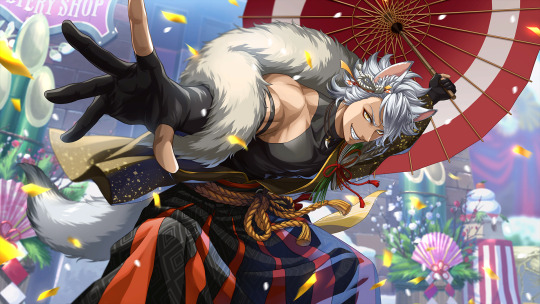
Happy New Year! Wishing you all the best. ...Don't read too much into it, I was just sayin' that to be polite!
Summon: Don't slack off just 'cause we're starting a new year. It's really easy to fall into bad habits, so.
Groovification: I got the hang of TAKOAGE down pat, now. Don't care how many of you wanna come at me, I'll take you all on!
Home: Is this the right way to wear this thing?
Home Transition 1: I've been studying up on eastern culture ever since I got this job. I mean, I can't just look the part and not know anything about it.
Home Transition 2: How many times do I gotta hear the guys from my dorm joke about how the shop's staff are all unapproachable...? They better be ready for what's comin' for them once I'm done with this job.
Home Transition 3: Malleus-senpai is able to stock the shelves and set-up displays in a snap with his magic. There's a lot I can learn from him.
Home Transition - Login: Welcome! ...Hey, don't laugh at me like that. I already know I don't look like I'm cut out for all this customer service stuff.
Home Transition - Groovy: Both sales and our TAKOAGE win record are through the roof. Seein' the results of all my hard work on paper actually gets me pretty motivated!
Home Tap 1: What gives me hang-ups while I work here is whenever someone asks me about some brand or another. Why're people askin' me about those things? Does it look like I know anything about 'em?
Home Tap 2: Not only can he get the job done well, but he's able to practice TAKOAGE properly, too... Jamil-senpai really makes no wasteful movements. I gotta try to make time for everything, too.
Home Tap 3: Just watchin' the way Floyd-senpai deal with customers makes me doubt everything I know about customer service. How is no one complaining about the way he's goin' about it?
Home Tap 4: Tch, the product displays are a complete disaster 'cause of all the unruly customers. You're tellin' me that Sam-san has to deal with these kinds of guys all the time?
Home Tap 5: This outfit's kinda difficult to wear. Walkin' around in it's one thing, but whenever I try to run, my feet get caught on the hem.
Home Tap - Groovy: You don't know where the thing you're looking for is? Got it, just wait a sec for me to finish putting this stuff out. I'll show you where it is. Y'know, just so I can make the sale.
Duo: [JACK]: Floyd-senpai, don't slack off now! [FLOYD]: You're too stuffy, Uni-chan~

Requested by @farfalla049.
#twisted wonderland#twst#jack howl#floyd leech#twst jack#twst floyd#twst translation#twst new years#mention: malleus#mention: jamil#mention: floyd#mention: sam
289 notes
·
View notes
Note
Hi! I'm new to your account, but just binged your "I bet on losing dogs" storyline, and I had a question and concept for you? How much is the reader free to interpret? I'm a theater kid, so I like her hobbies. But is there any specific physical traits you're writing for her? I know you mentioned that we were/are chubby, which is cool, but do you imagine any certain features? Because I'm Mexican American with certain features, so I was curious if you had a certain ethnicity set for her besides being half White/Jewish from Bruce being her biological father.
I also had the same question about Tiffany, because I'm currently imagining the Stereotypical All American girl. Kinda got that Disney Channel actress vibe to her. (Physically). I also had this really messed up though of the reader having to spend YEARS trying to keep in touch her mother's culture and such, learning dishes, traditions, going to local festivals by herself, having to learn how to do makeup and hair styles/products that fit her face and hair pattern. No one bothered to help or teach her. But than, suddenly Tiffany starts to steal those "habits", uncaring if they were very personal to the reader. Than everyone in the family suddenly starts to like the Reader's culture and such. (I had this scene in my brain where the Reader walks in on Tiffany is bragging about some music or dish "she" tried out from the Reader's culture, while the family are all happy and curious about it. Even when the Reader tried to introduce it to the family, everyone declined even trying it.)
I see the Reader so "Your Best American Girl" coded by Mitski.
Anyway I just wanted to ramble, bye!
ok so, I'm trying to be as vague as possible bc reader is supposed to be whoever is reading so there's no in depth description or specific height or build (except chubby in the prologue). i feel like i've basically made reader an OC which i hate but personally when I'm reading a fic, I just ignore things if I don't like them or they don't apply to me which is what i suggest yall do!!
the reader's mother is Palestinian/ Venezualan, like my own mom but you can change it if you'd like. it's important to mention that reader does have Bruce's jaw structure and face shape and shares facial features with Damian as well. It's small things like the ears, the roman nose, even the eye shape, point is that every time reader looks in the mirror she can see shadows of Bruce and Damian on her face. it's kinda like the vibe of "like him" by tyler the creator. I'm middle eastern and hispanic so I imagine reader with darker feautures like tan skin, thick brown hair, arched brows and long lashes but it's all up to you!
reader is very confused because while her dad is white, she isn't. she did try to bond with Damian and learn Arabic with him but he shamed her for not knowing and kicked her out his room, literally. she used to be embarrassed of her heritage when she was younger (courtsey of Tiffany calling her a mutt) but as she got older she realized how interesting her culture is.
she wants to learn arabic but has no teachers and it's a pretty hard language to learn if you don't grow up speaking it .she has no sources to help her and most of the time culture and traditions are things you grow up with and are passed down to you from family. her mom used to speak to her in arabic and feed her dates and sandwiches with olive oil and sugar and make her fried plantians so those things are very special to her, they're some of the only details she remembers about her late mother. so yeah reader is very "Your best american girl coded"
You're so on point about Tiffany, she's your classic all American girl. Blonde hair, blue eyes, long tanned legs and a set of pearly whites. she's the kind of white girl to act like she cares about other races but is secretly racist. you know what girls im talking about! and that prompt you sent with the food eats so hard, I have a scene mapped out with that in the upcoming chapters. I rambled too girl!!! you really got me thinking tbh but let me stop and actually write the next chapter.
#yandere batfam#yandere jason todd#yandere dc#yandere batman#yandere damian wayne#yandere tim drake#yandere x reader#yandere dick grayson#yandere dick grayson x reader#yandere bruce wayne#yandere bruce wayne x reader#yandere batfamily#yandere batfamily x reader#yandere batman x reader#yandere batfam x reader#yandere batboys
153 notes
·
View notes
Text
Ok so I noticed a really funny exchange that constantly happens with antisemites that goes something like "Ashkenazi Jews are white Aryan Europeans!!!!!!"
-"No they aren't, even the genetics very clearly show that they're at least half middle eastern (and the other half originates in classical era Rome)"
"Yes but that's from the patrilineal side and Judaism is only through the mother's side so according to their religion they're not Jewish!!!" Like, what the hell is this kind of reasoning? I've had that exact exchange more than once, do people know what matrilineality is? It's not even an old Jewish tradition it iirc originates in Roman times, do they think halachaic matrilineality erases 50% of the amino acids in your body or some shit? If your dad belongs to some matrilineal African culture and has you with a European woman are you just European? Would those smooth brainers go "Hmm what do you mean African? You're just European so I think these curly dark hair and brown skin and wide nose are just your run of the mill Scandinavian features"?
Man I don't know, if anything what makes this scary is how sensibility just completely goes out the window with these entities I'm legally obligated to count as people. They're trying so damn hard, "The joos are [whatever's considered bad these days] is literally just an axiom to them, and they will sooner change everything else around it than not consider it to be true for one second
168 notes
·
View notes
Note
is there shit like cultural modesty standards anywhere on siren?
From the cultures I've put time into, we have the Spiral pelagic villagers who value emotional modesty/reservedness - expressions of emotion are strongly curtailed, and it's gauche to even be openly happy about something. They have strong superstitions which dictate how people should behave, as would be expected in such a dangerous place to live, where survival is often a function of good luck rather than skill. The sea can kill instantly if you're in the wrong place and wrong time, so it's thought that pride and foolhardiness go hand in hand, and showing too much of any emotion (especially positive emotions) will tempt the sea to prove you wrong, punishing you for daring to be prideful
But I know you meant modesty as in dressing modest so on the other side of the world we have the royal coastal phocids of the eastern coast of the eastern continent. Some of them appear in the short piece of writing I did about Huarvaa - their heirs, and future rulers, must cover their entire bodies, faces included. In a world where drag is a significant factor in how easily someone can move (by flying or swimming), it's an expression of extreme privilege to wear bulky or obstructing clothing - essentially a statement that you don't need to swim or fly like common labourers. For these royal phocids, they don't even swim long distances - they use aquatic pack animals to pull their vehicles and barges, and it's considered unseemly for anyone of a certain high class to be seen going anywhere quickly. It also manifests in a kind of sexual conservatism among the upper classes - only a future sworn partner should ever see a veiled phocid's face, so showing/not showing face becomes a construct similar to virginity for them, and if someone else has seen your face before, you're not Pure anymore. And it multiple people have seen it? Slut.
I'd need to read back on my notes & I'm out of the house rn but I'm pretty sure the heirs (who hide their faces) are supposed to be the physical and spiritual successor to whoever came before them, so them wearing a veil is to aid in the illusion of a single being essentially reborn over and over. They have a Court of about 100 royals who get reborn over and over, and marriages are made at birth between sworn partners (aka the same married pair who've been continually reborn for centuries). Those who are considered the same person (an older royal and their direct heir) have no modesty boundaries between them as they are the same person in the eyes of the law so they can be undressed or at least show face around one another. To make matters more complicated these "two same people" phocids are usually not parent and offspring (but are usually related because this entire royal court is, by necessity, a closed studbook. To put it lightly)
58 notes
·
View notes
Note
Hi!! Out of curiosity, which MDZS character do u think about the most and why?
The answer is, without a doubt, Wei Wuxian.
Part of what makes WWX special to me is he feels really archetypal and yet the archetype doesn't actually appear in most of the western media with which I'm familiar. The archetype may be super common in eastern media or perhaps, more narrowly, Chinese media, but my point he feels singular to me and therefore interests me, and I'm familiar with mostly western media. The comparisons in this post are all comparisons to western media, since that's what I'm familiar with, and I tried to pick popular examples so that people would understand what I mean.
Wei Wuxian is a protagonist who does bad things. Very bad things. We see that in plenty of western stories, but it's less common in western fantasy. That is, you can read a million stories about professors sleeping with their students and making a very bad muck of their lives; you can watch Breaking Bad and The Sopranos, but more often in western fantasy you're going to have a Good Guy who does good and Bad Guys who do bad.
But, okay. There's certainly a significant portion of western fantasy in which no one is a Good Guy, and everyone is a little corrupt: Song of Ice and Fire, Interview With the Vampire. Wei Wuxian feels very different to me than the protagonists of these media, because Wei Wuxian is trying to be the Good Guy. He's well-intentioned. He is willing to stand against all of society to defy corruption and protect those who are weaker than himself. That kind of protagonist isn't very common in the kinds of "dark" genre fiction that are about the corruption of humanity or the political intrigues of society. If they exist, they're usually martyred and disappear from the narrative because they are too good for this world, too pure.
But the point of WWX is that he is not too good; he is not pure. He is good; he is brave; he is righteous; he stands up for the little guy--but he is also over-confident in his own ability. He overreaches. And people die because of it. Lots of people. And then, after he accidentally murders people due to losing control, he goes mad. The Nightless City massacre occurs not due to an accident but because WWX is careless and angry. He kills a lot more people then.
I will say that western fantasy is full of characters who turn to "the dark side. The threat of "going dark" has become, in fact, an integral part of most portrayals of the hero's journey. But in the media with which I'm familiar, when someone does go dark, they become the villain. They are not allowed to live, or if they live, they must still be vanquished. Star Wars is a quintessential example: Luke Skywalker is tempted by the dark side but resists; he is the hero. Darth Vader is tempted by the dark side and gives in. Even though he turns back at the end, he must still be eliminated.
Of course, there are plenty of villains who reform in such stories and then manage to survive. I think you could say that once resurrected, WWX is reformed in this way. He knows he lost control. He knows he hurt people. He's very sorry about it, and while he still has a drive to put his hand in to help others, I can't imagine him coming to the point where he would lose control again, and I also do not think he has the kind of anger or resentment that would allow him to be so careless and wanton with his cultivation again.
So, in this sense, WWX holds the place of a reformed villain, like Zuko or, say, Angel, from Buffy the Vampire Slayer. One thing to note about both of these examples--Zuko is shown to be "on the dark side" because of the family and culture in which he was raised, and also, he was a child. Angel was "on the dark side" because he didn't have a soul. That is, the excuses for why these reformed villains were ever villains at all exonerate them to some extent.
Meanwhile, WWX was a villain because he was full of himself. Like, it's still understandable why WWX was a villain: he sacrificed all the power he had for someone he loved; he still needed power to protect his own life when he was being tortured, and this took him down a dark path; he needed even more power to help the world fight corrupt fascists; he was villainized by society even before he became an actual villain because that society feared and desired his power; he was literally ostracized and rejected by his own family for doing the right thing. But in the end, it wasn't like he had no other choice when he caused the death of JZX. He didn't feel like he had another choice to save the Wens, but if he had not been so over-confident in his ability to control himself, JZX would not have died. And while I find the massacre at Qionqi Pass maybe excusable considering the pressures WWX was under, WWX goes mad after that. Also understandable, but there is no way in which the massacre at Nightless City is excusable. There's just no way to say it wasn't his fault.
Okay, but there are some reformed villains in western fantasy who really were villains because they just made some wrong choices. They were arrogant like WWX, or they were petty and small, or they had a sucky childhood but nothing that should've led them into darkness. These characters do exist, but I find them few and far between (and I will fully admit here that maybe I just haven't read enough western fantasy to come up with enough examples). When they do show up, they are not usually the protagonist (Snape); they more often play side roles.
And the point with these guys is that they did bad things because they were not well-intentioned. Their intentions change, and therefore their moral alignment changes. But WWX was always trying to do good. It's only at the very end that he is no longer trying, and he loses his mind partly because all of his efforts to do good have flown up in his face. I just feel like I never get to see someone who was honestly trying to help people so earnestly, and fucks it up because he was trying to do too much. The closest example is Xie Lian, and I think we can all agree Xie Lian never becomes anything close to a villain.
However, now comes the trait that really does make WWX different from any other protagonists I've ever read, and most I've seen on screen: he is all of the above, a reformed villain who was well-intentioned throughout his descent into villainy, who doesn't brood.
Everyone I mentioned above--Zuko, Angel, Snape--are all very serious people who are consumed by their pasts. If they're not dour or bitter, they're still unable to be light-hearted or carefree. Meanwhile, WWX is the definition of light-hearted and carefree. He has a lot of regrets and some guilt, but he really doesn't dwell on it. Like, he fucked up. He died. How else can he atone? He knows he can't make it up to the people he hurt. Might as well move on and not get in their face about it.
In general, WWX's personality is unusual for the kind of hero he is. While it's true that the wise-cracking, smart-talking hero is a staple of western fantasy (Iron Man, Spider Man), these aren't the kind of heroes who can make the serious mistakes that WWX makes--or, though they do make mistakes that lead to the deaths of countless bystanders, they are never really confronted with the enormity of those crimes. I know that some people will say that WWX is not confronted with them either, that his crimes are not dealt with seriously enough in the text. I admit that I was very surprised that WWX blames the death of JZX on JGY during the final showdown in the temple. In the end, however, I think there are enough questions about whether WWX is actually a Good Guy that the story of MDZS seems quite different than, say, many western superhero stories, in which yes, superheroes do bad things and make mistakes, but are still ultimately our heroes.
But the other thing about WWX's personality that is unique for such a protagonist and also further distances him from heroes like Iron Man is this: WWX is pathetic. He's allowed to be pathetic, on quite a few occasions. He pretends to be a child. He pretends to be a damsel in distress. He purposely harasses and teases others in a way that is actively annoying to them. He's laughable. The closest parallel I can think of to how deeply WWX is willing to abase himself and annoy the fuck out of others in Deadpool, but the thing about Deadpool is that he is ultimately comedic. You know you're going to laugh if you're reading a Deadpool comic or watching one of his movies. Also, while Deadpool is a badass, need I remind you that WWX is the most powerful and the most feared person in the entire world, perhaps in all of history. The fact that WWX is as powerful as he is and still throws himself on people he likes and pretends to weep is only matched by Luo Binghe, but LBH is different in that his willingness to be pathetic is a tactic of manipulation. Meanwhile WWX is pathetic for fun; he likes to annoy people; he's ridiculous; he's laughable.
He's also lovable, but imo, like Deadpool and like LBH, I don't think we're always supposed to find him charming. We're supposed to recognize that these characters sometimes go too far for a joke. We're supposed to be annoyed at times, at least imo.
But in the end, we are supposed to like WWX. We're also supposed to feel really sorry for him and sympathize with him for what he did. He's an enormous woobie, while at the same time he massacred thousands and then laughed it off. Who does that? Who does it like the Yiling Lazou? When you add in the fact that he's super gay, but all his gay fantasies consist of farming and eating Lan Wangji's cooking and talking about fishing and keeping house, I'm just left asking, Wei Wuxian, who the fuck are you? Who the fuck can match you?
This is why I spend so much time thinking about this character. I can't actually wrap my head around him, and frankly, the way MDZS is told doesn't help. MXTX actually does not really get into WWX's head very much once he starts his path of demonic cultivation, and while we get some insights as to what is going on with him through flashback and his dialogue at the time, I am still somewhat in the dark about why he made the choices he did.
The only character I've ever encountered who even comes close to WWX is Spike from BtVS, and WWX is still on another level.
Lastly, I'll say that the relationship between Wei Wuxian and Jiang Cheng is another thing I have never witnessed in western media. It is so complex and interesting to me that I could make a whole post on it, which is why even though the answer to your question is by far Wei Wuxian, if WWX didn't exist, Jiang Cheng would win this question by a landslide.
98 notes
·
View notes
Note
Hey there. I'm writing a story set in New York City and am not American. I have few characters, but most of them are arab or white. I can't help but feel a bit wrong about it, given that America is much more diverse than that, and NYC being an emblem of that. Do you think I should force myself to include more representation or should I just tell my story, and leave that more diverse cast to some other story I could write? I know this is a neverending debate and there are many opinions about it, but I've always agreed with everything you've said in matters of representation in fiction, and so I'd be curious to know your personal answer on it.
I'm a little confused by how you're using "representation," here. It sounds like you think representation = "randomly sticking BIPOC everywhere." I think when most people use that word, it means something more like "create an accurate or at least plausible depiction of a group or place." In actual New York, there are plenty of Middle Easterners and white people who live in relatively homogeneous small communities where they might only see someone of a different ethnicity on the subway. If your story is set in one of those communities -- and you do stick some random BIPOC in that subway scene, because that's plausible -- then it sounds like your characters might be an example of good representation.
(Note: if you're not writing something set in the real world, but it features human beings, it needs to represent humanity as a whole, unless there's a good in-world reason not to. But if it's our world? You can get specific.)
Here's the catch, tho: plausibility is relative. If you've absorbed some biases and haven't done enough research, then you might end up writing something that feels plausible to you, but which isn't actually representative or plausible to anyone else. The way to avoid this is to do the research and check (to the best of your ability) your biases. For example, you aren't American, I assume you've at least visited NYC? If not, you should. You can visit some of the communities I mentioned! You can eat in restaurants, visit mosques, have conversations with actual real people who are living the life you're writing about! If you don't have the time, money, or spoons to do that, there are other ways to do good research -- films and YT/Tiktok videos made by people from the communities in question, for example. But you'd need to watch a lot of them to get a good representative sample.
I recommend this book to all the writing students I've taught at Clarion, and other writer workshops: Writing the Other, by Nisi Shawl and Cynthia Ward. There's a particular part of it that seems relevant here, which is a kind of hierarchy of "appropriate" appropriation, I think first mentioned by Diantha Day Sprouse but included in Writing the Other. Basically it says that if you want to write about a culture that isn't your own, you can learn about that culture in one of several ways: a) You can be an Invader, and just go take whatever intellectual and artistic tidbits from that culture that you want, regardless of how damaging this might be to members of that group. Example: non-Indigenous people who write about actual secret practices, or who encourage the desecration of sacred places. b) You can be a Tourist, in which you're still mooching from that culture, but at least you're figuratively paying someone for it and accepting tidbits that the culture has chosen to sell. Example: getting a sensitivity reader. Or c) you can be an Invited Guest, who brings in as much as they take out, and who has formed relationships that are beneficial to all involved. Example: being part of an exchange program, both as a student and later as a host, and maintaining those friendships outside of the program.
The goal is to be an IG, but that isn't always possible. Tourist is still better than being an Invader. (...I feel like I'm leaving out a category. It's been a while since I read the book; any more recent readers want to check me here?) But the closer you can get to actually participating in that culture, the more your work will be informed by reality instead of biases or misinformation, and the more likely your work will read as plausible not just to you, but to your widest possible audience -- people familiar with the culture and people who aren't.
(I'm a little concerned about your phrasing of "force myself to include more representation," note. Why would that need to be a forced thing? A writer's goal should be to write something that feels lived-in and authentic to [if it's a real place] most people's experience -- not to meet some arbitrary standard, but because that's how you master immersion and characterization. If good immersion and characterization feel forced to you right now, that suggests you need more practice. I recommend writing short stories!)
#answered asks#long#sorry I took a while to reply#some asks require more nuanced replies#and I put this one in drafts because it was so long#then forgot it was there#and yeah I'm aware this might be a disingenuous ask#but I am choosing to treat it as good faith
159 notes
·
View notes
Text
"You're far more powerful than the people of this planet, yet you defend them. Why?"
"Big talk from the guy that was defeated by those very people."
"Hm. Don't make me laugh. The... beasts that managed to delay our reign were far from human..."

In other words, I decided that the ancient mystic warriors that created the Key to the Prison Dimension are now dragonfied... somewhat successfully-
More info on them below, why not.
Almost a thousand years ago, after the creation of yokai, dragons of the time advocated for peace between humans and yokai. However, the tensions only grew as each attempt ended in failure, by the fault of one side or the other. Eventually, a war was declared, and the powerful beings ended up as targets for many.
The story is typically different depending on the location. Generally, in the East, dragons were more respected by humans than yokai, and the West was the opposite. Draxum's family grew up in the Western yokai cultures, primarily, whereas the Hamato clan originally lived in the East.
One by one, by either human or yokai, dragons were hunted down, often seen as either a threat due to their power, or as foolish for their optimistic desires. When the Krang's full army made it to Earth, only four remained across the globe. Seeing this massive threat to life itself in their home, they gathered together and sacrificed themselves in order to create the Prison Dimension, locking away as many Krang as they possibly could and trusting the stragglers could be taken care of.
With them gone, the Yokai were eventually forced to hide away, with any remaining rebels quickly struck down. Currently, the only remaining proof of the dragons, aside from many mixed stories and historical drawings, is the small, inferior yokai breed (think like Bruce and his gang.)

Blazure: Having lived in the Eastern side, Blazure was a constant target of human armies. He used to have a small group of fellow dragons he often socialized with in surrounding territories, but they were all taken down by the kingdoms around them eventually. His home no longer safe, Blazure spent most of his remaining life traveling and trying his best to help people of all kinds where he could, without getting killed.

Pyre: Immediately after the war was declared, Pyre set off with as many Yokai as he could, trying to guide them to safety. While he still wholeheartedly believed they could live in harmony, he also recognized that reasoning with humans was not in his personal skillset, a lesson he had learned the hard way many times. Instead, he took to running with the yokai he could protect, gaining new members at every turn. It's rumored that he was the start of the first Hidden Cities.

Shilong: Highly revered by the humans of his territory, Shilong was a mighty warrior who, unlike many dragons, had no problem resorting to physically fighting for his beliefs. Many yokai saw him as a threat and even a weakness of their kind due to his desire for peace between them and humans. Because of this, he was often attacked. Even still, he stuck around and defended human villages and cities when he saw it necessary.

Zuma: Settling down in Japan with a few others, Zuma was highly worshipped by multiple human clans. They were free to walk the streets of these villages unharmed, and often received gems, food, jewelry, and other gifts, which they always made sure to repay in one way or another. Overall, they were well treated and defended from the many yokai who wished to hunt them down.
Curse of Icarus Masterpost
#I'm not sure if they represent the four mystic warriors from the show perfectly#certainly not quite as well as the turtle bois#buuttt I still really like them! So I don't care lmao#taking a lotta creative liberties here#but the lore do be real#sorry if any of the text is a little eh#we just got some bad news irl and I honestly just want this posted and done with lmfao#dragon au#rottmnt#rise of the tmnt#rise of the teenage mutant ninja turtles#rottmnt mystic warriors#rottmnt au#rottmnt draxum#he's mentioned and relevant#coi au#curse of icarus#dragons rise au
125 notes
·
View notes
Text
Things about Greece you're (probably) getting wrong
When you say "Greece" or "Greek", that's automatically referring to Modern Greece and Modern Greek. It's an existing country with a population of around 10 million people. The Modern Greek language is spoken natively by those 10 million along with 1 million people in Cyprus and around 2 more million in diaspora. If you want to refer to Ancient Greece or its history/culture, just add the word "ancient" to it.
The Greek name for the country is "Hellas". "Hellenic" is an adjective used for non-human nouns. Don't call yourself "hellenic" even if you have Greek roots, you're basically calling yourself "Greek thing".
There is no one correct way of pronouncing Ancient Greek as a whole. That language spanned over a thousand years and across places that didn't communicate easily or were outright hostile to each other. It's like claiming that Shakespeare's works should be pronounced with an Australian accent.
Along with the famous 300 Spartans, in the battle of Thermopylae there were also 700 Thespians (not actors, people from the town Thespiae) and according to some sources, also 900 helots (slaves) and 400 Thebans.
The town of Sparta exists in modern day. However, if you visit Greece, unless you actually are from Sparta, do NOT call yourself a Spartan, no matter what school/university you went to. "Spartans" is the name of a far-right, outright neo-nazi political party, so calling yourself that here equals to associating yourself with that.
Greek houses in American campuses sound weird. Do those letters (some of which are wildly mispronounced, btw) even mean anything
Democracy in Ancient Athens was not fair by today's standards. It was mostly a glorified, expanded aristocracy. The "demos" that had the authority to vote only consisted of land-owning Athenian men. If you were a woman, a slave, poor, an immigrant, or a child of immigrants, along with other descriptions I might be forgetting right now, you didn't have the right to participate in the ruling.
Oh yeah, the "birthplace of democracy" very much did have slaves. Some whom were prisoners of war.
Greece is on the southern end of the Balkan peninsula, located in South-Eastern Europe. However, many Greeks are wildly racist and will not admit we're part of the Balkans or Eastern Europe. There are cultural differences due to Greek not belonging in the Slavic languages (the most common language family in Eastern Europe) and for political reasons, but the main reason this distinction happens is very much racism. They prefer to be called a "Mediterranean country" (because then we're associated with countries like Italy and Spain, you know?)
Greece never recovered from the financial crisis of 2008, and has only been going downhill since then. However, the war reparations that Germany never paid Greece for the damages and the deaths it caused in WW2 is estimated to be over 200 billion euros. The German government considers this matter "to be in the past" (since they never paid them, I guess, we can forget about it!), yet is one of the countries that most strongly demands Greece to keep paying back the loans it took over the years from the EU. This is a very painful matter for all of us (especially considering there are people still alive who witnessed the destruction and death the nazis brought to the country, and now they along with their descendants are paying taxes that'll eventually reach German pockets), yet racism centers around hate for other Balkan countries and Turkey. Divide and conquer I guess.
36 notes
·
View notes
Text
IWTV S2 Ep1 Musings - Daciana: History through Visual Context in Ploiești, Romania
I immediately fell in love with The Vampire Daciana & her Romanian castle, and wanted to know more about it all.
We already know how much the set/costume designers on IWTV looooove attention to detail; they tell whole stories just through architecture, furniture, clothes, etc. So I was like OK, AMC, I see you; lemme start doing some reading up on Romania, so I can try to figure out what might be going on with Daciana. (Warning: I know eff all about Romania or Eastern Europe.)
ROMANIA
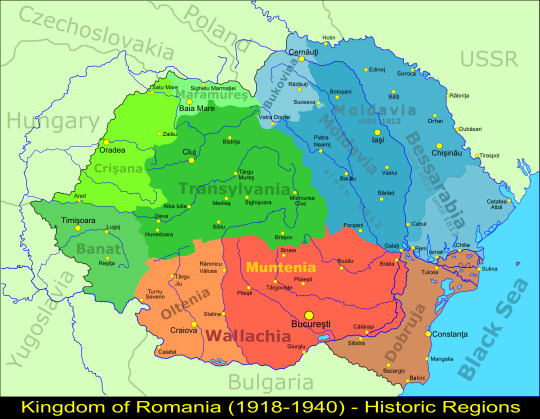
Map of Romania. Ploiești's the dot just under Muntenia, north of Bucharest, the capital. Ploiești's part of Wallachia, the IRL kingdom of Vlad Tepes (aka Dracula). Louis & Claudia went there in the 1940s, so I hope this map is accurate enough. (There's this map, but I dunno the date.)
DACIANA
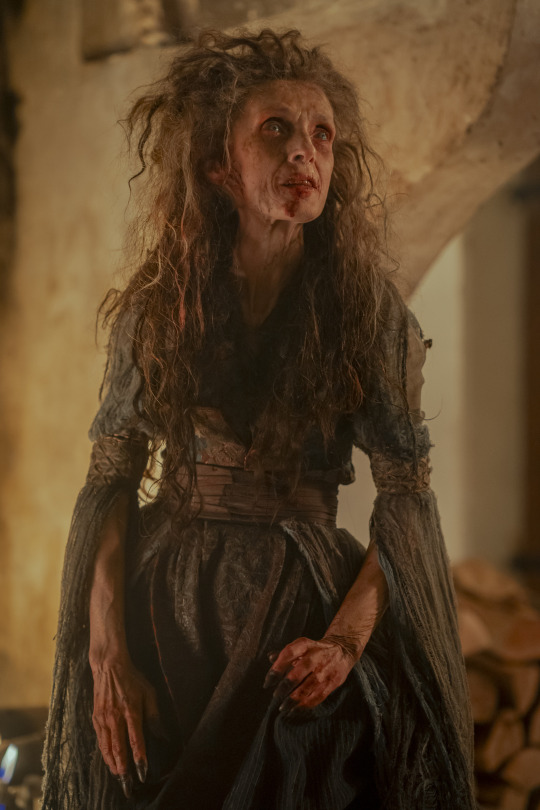
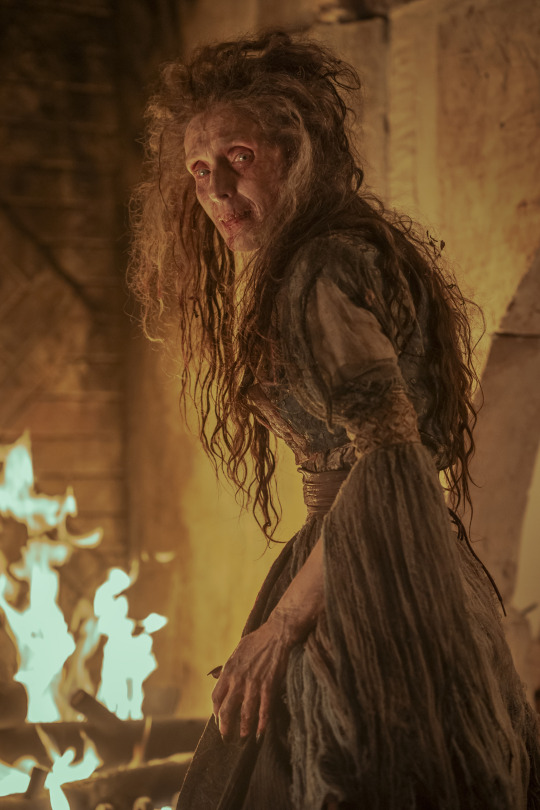
The most obvious thing about her is that she's not dressed in the typical traditional Romanian folk clothing I see all over Google, full of white-red-blue/black palettes.
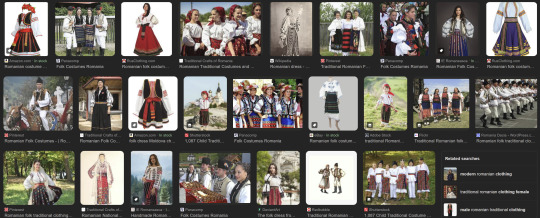
Daciana's not following traditional 19th/20th-century Romanian nationalist images. Her green/brown palette & silhouette is telling, as she lacks the puffy white blouses & dark skirts. (Despite her name, I'm ruling out her being Dacian (X X)--you think you're FUNNY, AMC! But IDK about Cezare Romulo (X X); might do a Pt2!)
Sleeves
First thing's her trailing slashed open sleeves, which were screaming Medieval! at me. Here's some 15th century Renaissance examples, but with surcoats, which is different, but the sleeves reminded me of hers so IDFK.

We could chalk this up to Daciana's design as just generic "medieval" fairytale stuff and keep it moving. But to give her a fair shake, I looked at local examples for anything similar that's more recent.
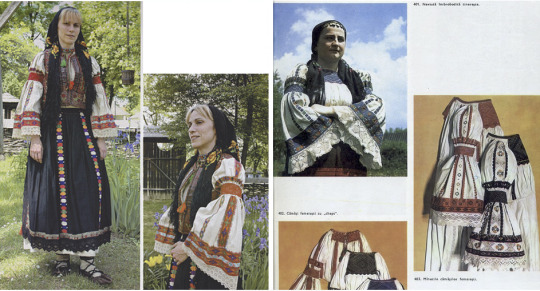
Traditional clothing from Huedin, Romania (north Transylvania), (X X).
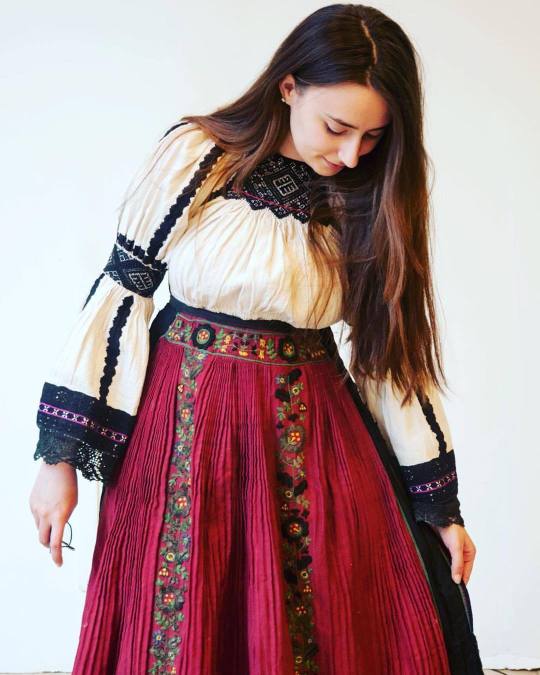
Traditional clothing from Cluj, Romania (north Transylvania).
Keep Transylvanian/Muntenian cross-cultural contacts in mind when we get to Daciana's castle, cuz it's important!
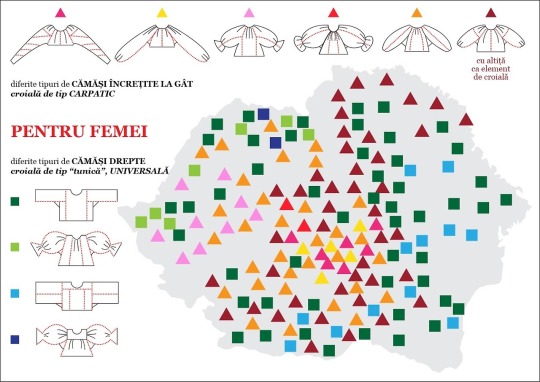
Wrt rarer non-puffy sleeves, the square cut (light blue) seems to be more prevalent in Wallachia/Moldavia/Bessarabia (southern & eastern Romania); while the rectangular cut (dark green) is all over Romania, but definitely has a concentration in Wallachia & Moldavia.
And this makes sense, cuz the style seems to also be prevalent in 19th - 20th century Bulgaria, just south of Wallachia. Hrm....

Daciana's sleeves hang very long--the only example of super long sleeves I could find is a 19th century one at the Met (C.I.47.3.4a–d). The only example of slashed sleeves I could find is in this museum exhibit at Bran Castle (yes, THE Bran Castle--I'll get to it in a minute!)
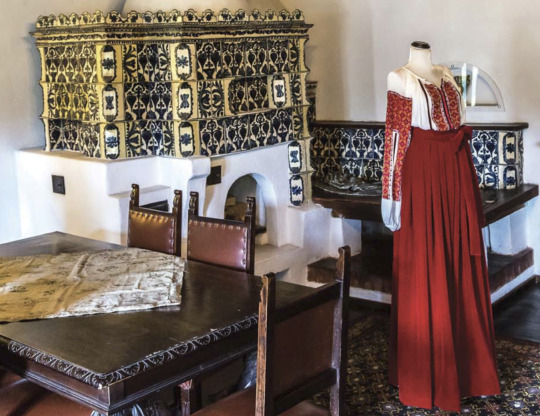
Belt, Bodice, & Fabric
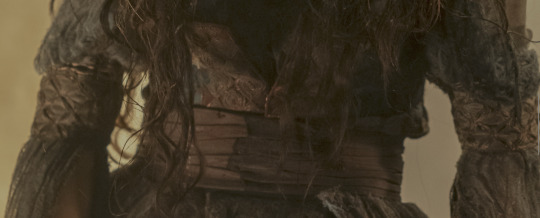
Daciana's belt is so plain compared to everything else. Is it supposed to be a leather Romanian chimir (worn by mountain/forest folk)? Those are only worn by men though? Or it depends? Or is it a just a plain cloth belt? It's reminding me of these examples (X X):
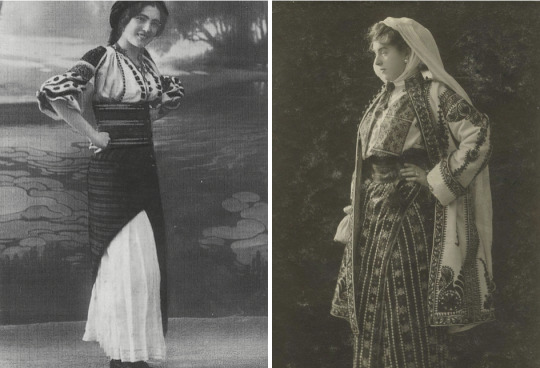
I wish I could see more of Daciana's bodice, if there's any particular kind of cut or patterns. Is the diamond netted/knotted/roped pattern on her arms significant? Her fabric is interesting, too:
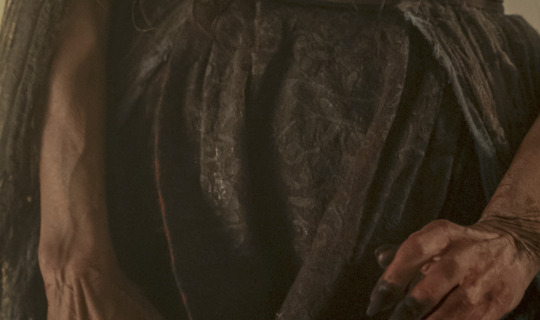
What's this embroidery? Brocade? (Byzantine-Renaissance?) Damask? (c. 14th-16th century?) Lace? Something else? My brain wants to assume it's imported? Meaning: she's hella rich. Cuz like, the traditional Romanian blouse & skirt used to belong solely to peasants, b4 19th-20th century aristocrats started wearing it, too.
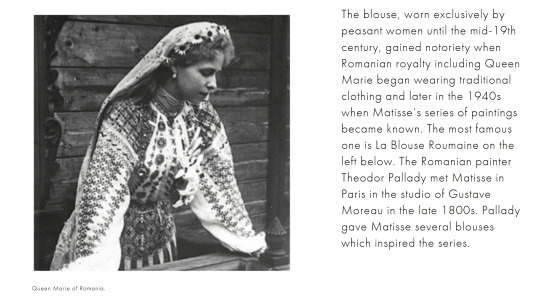
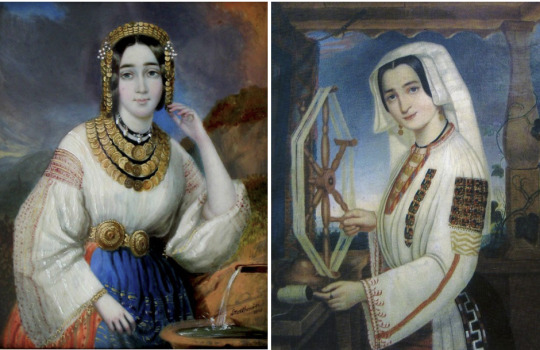
IDKY--more reading led me to a whole bunch of complicated stuff, that can probably be simplified by just saying: The Ottomans. XD

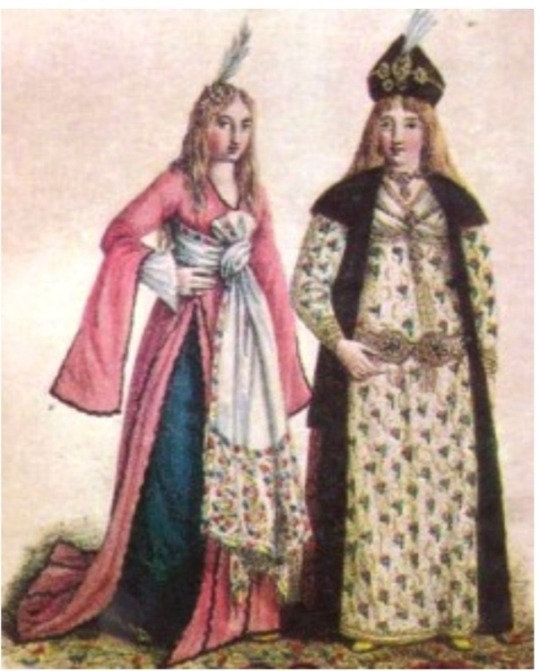
The pre-19th century Romanian aristocracy wore super opulent clothes, inspired by not just the Ottomans (X), but also the Byzantine Greeks (via 18th century Romanian Phanariote boyars (X X X)), etc. But aside from the hanging sleeves, Daciana's dress doesn't really resemble any of these foreign examples. However, it does track with my theory that Daciana predates the 19th-century Romanian nationalist/traditional clothes that became so iconic later on.
Like Louis & Claudia did, let's follow Daciana to her castle! ^0^
DACIANA'S CASTLE
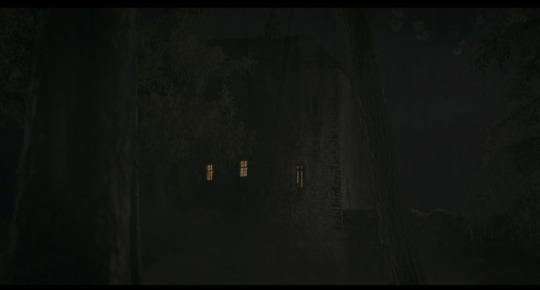
I NEED to know if AMC filmed on location in Romania, or if Daciana's castle is just a studio set/green screen.
The interior's nowhere near what I expected, considering Daciana's haggard appearance. It's really nice--clean & tidy. No spiderwebs, no chipped plaster/paint, not even any bloodstains--but I've mentioned before that I think it's indicating that Daciana's a mother who takes better care of her home (and "child") than herself.
Archway
The first thing is the arch when they first come in (noticeable mostly cuz of how Louis had to bend down to get in, he's so tall).
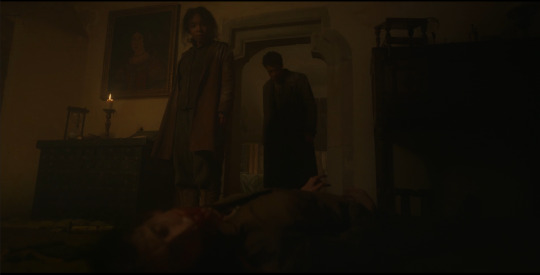
These types of doors/arches are called "shouldered arches," dating from the Medieval-Gothic periods, which Europeans adapted from Islamic architecture during the medieval Crusades. (Examples inc. Lainici Monastery in Wallachia, and the Academy of Art in Cluj-Napoca (north Transylvania).)
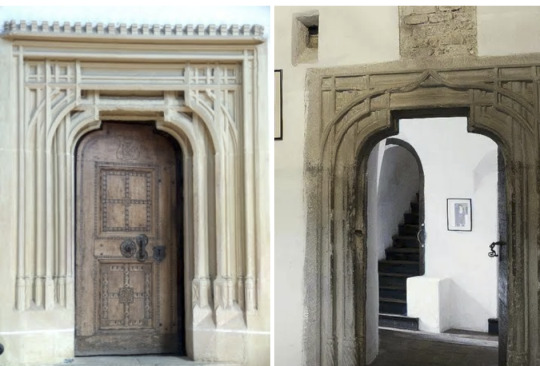
The left pic's Biertan Fortified Church, in Sibiu (south Transylvania). (Another door.) The right pic's Bran Castle, in Brasov (south Transylvania). (Another door.) (Vlad Tepes/Dracula historically never owned this castle, but pop culture says otherwise.) Both places were built by the German/Saxon Transylvanians in the 14th-16th centuries; which might help date Daciana's castle, if not Daciana herself? (The Saxon Transylvanians were in Wallachia, too.)
Wall Ornamentation
The last thing I'll discuss is the wall ornamentation/decoration:
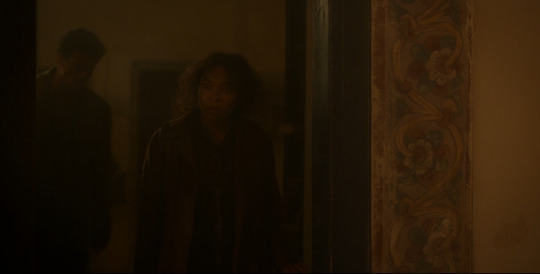
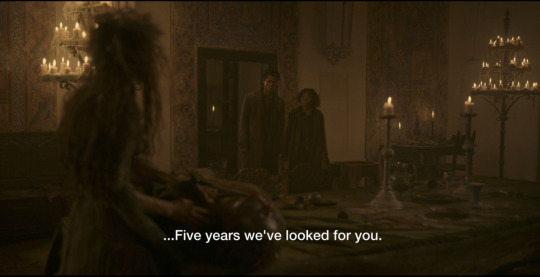
The painted floral trim everywhere instantly reminded me of The Witcher 3, as found in Hungarian, Polish, Ukranian etc buildings. Apparently the designs are all related to fertility, growth/luck, and the Tree of Life. Walls (X X X) and doors (X X) were painted. You can see northern Romanian painted ornamentation in Suceava (Bukovina).

There's painted wall designs in southern Romania, too.

"The research of the popular interior in the Argeş and Muscel areas leads to the determination, along with a local specificity, and some Transylvanian influences, in the contact areas between southern Transylvania and northern Muntenia. In the researched areas, two lines of development of the popular interior can be observed, one relatively simple and the other complex. If the first is the prerogative of a typical Subcarpathian interior, the second represents a distinctly Transylvanian form, which was also imposed due to the presence of the Transylvanian population in the south of the Carpathians, settled in numerous villages." -- (Google Translated from Arta populară din zonele Argeș și Muscel, 1967)
(The website RomaniaDacia has A LOT to say about Transylvania, and the impact of the Germans, Saxons, Hungarians, etc on Wallachia & the rest of Romania.)
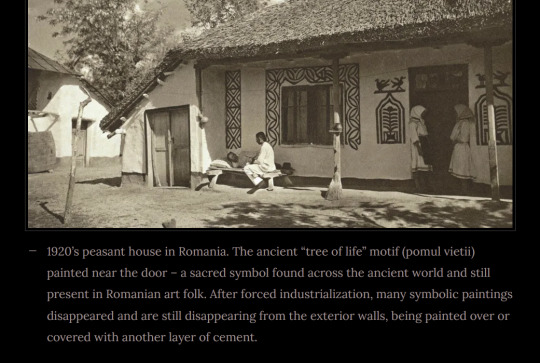
Sure enough, I was finding way more carved ornamentation (X X X X X X) than painted ones.
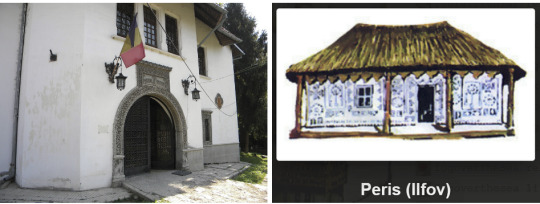
But I wonder if that's why a lot of southern traditional Romanian interiors I've been finding have totally plain whitewashed walls, too, with no painted ornaments, just tapestries (X X). I did find Romanian interior floral wall painted trims (X), but not nearly as much.
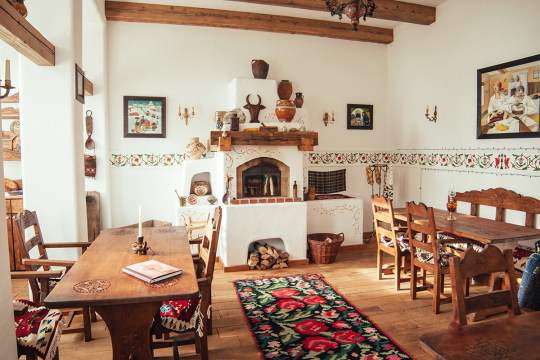
Cuz actually, the closest comparanda I was finding for Daciana was Northern European rosemaling (X X), which is also giving me medieval vibes (X); specifically: trims on illuminated manuscripts like the Book of Hours (X X X)--which we know from Lestat in S01E06.
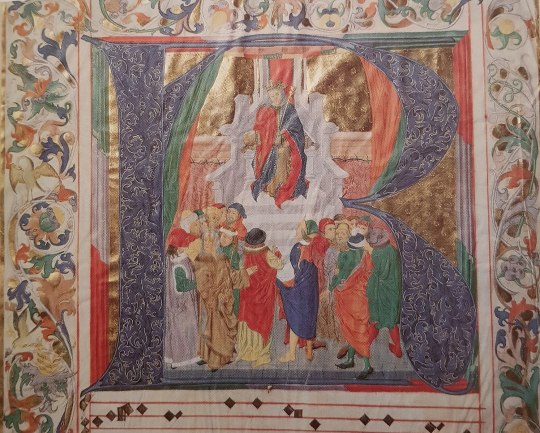
And we do see some Romanian medieval fresco borders & frescoes that had been plastered over & whitewashed, in Biertan's 15th century churches, and in 13th-15th century Darjiu (Transylvania).
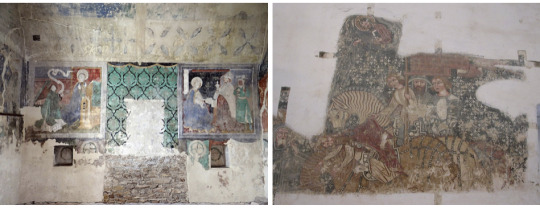
So, I wouldn't be surprised if a lot of Romanian buildings (especially castles with whitewashed plastered walls) were formerly painted similar to Daciana's. Unfortunately, I just can't find an example or figure out what AMC might've been inspired by--Romania has hundreds of castles & churches.
So, I'm tapping out--this is the most I could find so far. U_U
Results? Inconclusive! 😭 My Google-fu has failed me, LOL!
I still have no idea what time period Daciana could be from. We could go several routes:
Go by her name, and say she's ooooold AF, an actual Dacian. She's just been collating Eastern European culture as she ages, but stopped at some point (as her mind deteriorated)
She's medieval, somewhere roundabouts the 14th-16th century (making her ~500 years old, the same age as Armand--but she's weaker (as I've theorized b4), which is why she was able to burn herself up.)
Settle on her being a local Wallachian from Southern Romania, likely pre-19th century / pre-industrial early-modern Europe
Handwave everything aside as Renn-Faire fairytale fantasy; let the tale seduce you~!
OR, we can just bully AMC until they give us an extended BTS look at how Daciana was conceptualized, telling us all the tea about her! 😈
#interview with the vampire#iwtv tvc metas#fashion history#architecture#medieval europe#read a dang history book#the vampire daciana
95 notes
·
View notes
Text
Okay, so I received an ask in response to an MHA critical post I received last night that I originally responded to, but then decided to delete the ask and the original post because I didn't want to get into an argument.
However, I feel like I should address one of their complaints about a post I made last night. That I was being too dismissive on the cultural reasons for some of the writing choices Horikoshi made because I am obviously not a part of the culture that Horikoshi grew up in and is commenting on in his piece of work.
I tried not to dismiss the cultural reasons entirely in the post though, I just said I don't think you can entirely blame Hori's writing choices on them. My cited example was there are other shonen jump mangas that don't go out of their way to gruesomely kill their villains (which is what I'm taking fault with.) I understand that the death penalty is a common response to murder in japan, but within the realm of fiction of shonen manga doesn't have a trend of killing all their villains.
But yeah, that might have been a shallow argument.
So there are different lenses of fiction you can criticize Horikoshi's writing on, because every piece of fiction is in fact influenced by the culture it's in, as well as obviously the author's personal life and unconscious biases but that's not all. There's also genre to consider, and influences / inspiration the author might have taken from other works.
For example, there is also genre in particular MHA is written as a response / commentary to both western comics and classic shonen jump manga. Horikoshi said in an interview:
“Probably have to be Goku and Spiderman. To me, when mentioning heroes, these two are the ones that I think of. In Goku’s case, it’s the reassurance that everything is going to be fine he brings when arriving.”
There are multiple critical analysis lenses that you can analyze a story from. If you're talking about MHA from a feminist lens then you're likely to stick to topics relevant to that, like say japanese feminist movements. If you're talking from the sociopolitical angle then it's relevant to discuss collectivism, and especially how it inspired the Todoroki Family. However, my intent wasn't to dismiss sociopolitical reasons as why Horikoshi chose to write the story this way, but to say it's not the only reason that informs Hori's storytelling choices. MHA isn't just one thing it's multiple thing, me deliberately choosing to talk about MHA as a response to both eastern shonen manga and western comics is a valid critical lens to apply to the manga. You can talk about both obviously, but that was a pretty short post. Perhaps I didn't word my post the best but please try to be understanding that I can't make a post covering all of my bases on leaks night.
For a manga where Horikoshi cited his concept of heroism comes from Goku and Spiderman, they both don't kill their villains, Goku specifically let Vegeta live so if those are his inspirations the choice to kill every villain is weird to say the least.
I can make the argument that MHA fails as any kind of meaningful commentary on comics in general because it doesn't seem to understand the comics it is taking inspiration from. The X-Men are the underdogs in their story, not members of the privileged class they are the outcasts. Batman doesn't kill people because he believes that most of his mentally ill victims turned villains deserve a second chance and he can't dictate who deserves recovery and who doesn't.
If anyone reading this post is curious, here are posts by @siflshonen that discuss both the manga influences and comic infleunces easter and western infleunces on MHA, and also the cultural ones. They are also really long posts because those topics require a great length to discuss critically. This one is about MHA's manga DNA in regards to Bakugo's character, and specifically references Yu-Gi-Oh and Kaiba's character as well as Jonouchi as response for Bakugo's development arc from bully to best friend. This one discusses more about the nuances of collectivism. This one is in reference to the Todoroki family, it discusses both collectivism / japanese family roles / honnae and tatamae concepts that the Todofam is critiqueig, and also how Enji is inspired by eastern ideas of heroes while All Might is inspired by western ones. (Therefore it's not a wrong critical lens to compare MHA to other shonen manga and western comics because that is literally what the manga is taking inspiration from and commenting on).
Here's a powerpoint presentation by @sans-san that discussed Hegemonic Masculinity in Tokyo Ghoul in terms of work culture and how the CCG is inspired by that, which I think also applies to Enji's character as well.
This post by @bnhaobservation spoke about how the Todorokis decision for not disavowing or abandoning Toya after he was sentenced to life in prison would still be a progressive ending to the TODOFAM arc, and while I still wouldn't have been satisfied by that ending I'd at least be able to accept it. That is however, not what we got, we got Toya dying a slow agonizing death while hooked up to life support. So we could have still gotten a slightly softer ending where Toya's at least allowed to live that would have still been in line with the values of the culture that produced MHA.
This post by @bnhaobservation also talks about how the Todofam plotline can still be seen as progressive in some ways in regards to his criticism of Enji's parenting, because of certain outdated attitudes of parenting that still exist about Enji pushing Shoto to his absolute limits.
However, I don't want to debate the person who sent the ask, I just wanted to clarify I'm not trying to make a reductive statement that sociopolitical circumstances have nothing to do with Hori's writing choices, but that you can also analyze it from a lens of genre, commentary on comics and shonen manga, and also the predecessors he's taking inspiration from. All of these things have an inspiration on Hori's storytelling choices.
Since I'd rather not debate, now that I've gotten clarifying things out of the way I'm actually going to use this post as a book reccommendation.
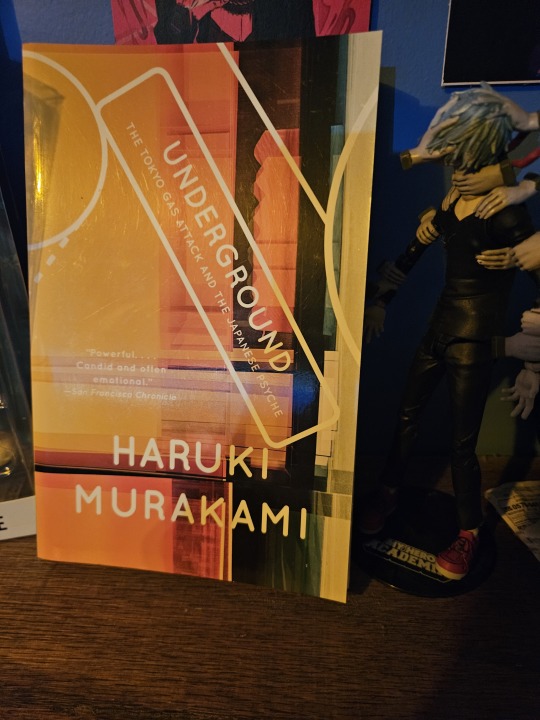
Here's Shigaraki with Underground, one of my favorite books. It is a non-fiction work from famed fiction author Haruki Murakami about the Saren Gas attacks.
On a clear spring day in 1995 five members of a religious cult unleashed poison gas in the Tokyo Subway system. In an attempt to discover why, Haruki Murakami talks to the people who lived through the catasrophe and lays bare the Japanese Psyche.
For those who are unaware the Saren Gas attacks were a terrorist attack where members of the Aum Shirikyo cult released saren gas in the public subway system. It is the biggest japanese terrorist attack in modern japanese history and at the time and even the modern day it was a great shock to them as a whole.
The book consists of several interviews with the victims of the attack, and they are incredibly harrowing to read I remember crying while reading this book multiple times. However, at the end of the book after giving considerable time to let the victims share their stories Haruki Murakami also devotes space in the book to interviewing former members of the Aum Shirikyo cult.
Haruki clarifies his intent in his decision to include testimonial from the cult in the afterword of the novel. "As I worked on this book I attended several of the trials of the defendants of the Tokyo Gas attack. I wanted to see and hear those people with my own eyes ad ears, in order to come to some understanding of who they were. I also wanted to know what they were thinking now. What I found there was a dismal, gloomy, hopeless scene. The court was like a room with no exit. There must have been a way out in the beginning, but now it had become a nightmarish chamber from which there was no escape. [...] To all of them I posed the same question, that is, whether they regretted having joined Aum. Almost everyone answered: "No, I have no regrets. I don't think those years are wasted" Why is that? THe answer is simple - because in Aum they found a purity of purpose theycould not find in ordinary society. Even if in the end it became something monstrous, the radiant, warm memory of the peace they originally found remains inside them and nothing else can replace it. [...] However, as I went through the process of interviewing these Aum members and former members, one thing I felt quite strongly was that it was't spite of being part of the elite that they went in that direction, but because they were a part of the elite. [...] However, we need tor ealize that most of the people who join cults are not abnormal; they're not disadvantaged; they're not eccentrics. They are people who live average lives (and nmaybe from the outside, more than average lives), who live in my neighborhood and yours.
Haruki interviews members of Aum Shirikiyo because he wants to make the point that the people in these cult aren't from a dangerous fringe element of japanese society, but rather they are normal people, some of them even highly educated. The capacity to commit those crimes exists in normal people, and also the capacity to fall victim to a cult.
The Ikuhara anime Mawaru Penguindrum is heavily inspired by both the Saren Gas attacks and the questions that Haruki Murakami asked in the Underground. Fully covered here in this article: Exploring Mawaru Penguindrum 2011 from a historical, cultural and literary perspective here.
Underground was Murakami’s attempt to interview survivors of the Sarin Subway Attack. Apart from learning the perspectives of ordinary citizens involved in that shocking incident, he also managed to interview several members of Aum Shinrikyo and tried to get their point of view on the matter. (In the Japanese edition of the book, the interview with the cult members were published in a separate book, titled The Place that was Promised.) It was an important piece of journalistic work that criticized the public’s attitude of questioning what happened, instead of asking the proper question of why it had happened. In the anime, viewers knew that an event took place in 1995 that affected all the characters, but what exactly was the event about? Why did the people do that? What social factors attributed to the occurrence of such event? These are the questions that Mawaru Penguindrum asked, and one that we were left to ponder on.
Ikuhara and Murakami both exist in the same culture as Horikoshi, Haruki is an incredibly prolific japanese author and he was born in 1945 but both of them are able to ask more meaningful questions about the society they live in then Horikoshi accomplishes with the league of villains and the todoroki family. Haruki Murakami emphasizes the humanity of the aum shirikyo members and that they are not lunatic fringe members, and Mawaru Penguindrum is about the extreme social pressures that people especially children can be a victim of.
Literature is influenced by the culture it takes place in, but it's also a response to that influence and the piece of art that Horikoshi wrote just isn't as thoughtful of a response than what was written by both Ikuhara and Murakami.
More book recommendations if you're interested. The Setting Sun, by Osamu Dazai. Pachinko by Min Jin Lee. How do you Live? by Genzaburo Yoshino. In the Miso Soup by Ryo Murakami. People who Eat Darkness by Richard Lloyd Perry. Night on the Galactic Railroad by Kenji Miyazawa (I'd argue this is an example of good collectivism). The Memory Police by Yuko Ogawa. Out by Natsuo Kirino. There was a couple more I wanted to include but they had cannibalism in them so I thought it better not to reccommend them.
89 notes
·
View notes
Text
some notes on specifically "middle eastern" (mashriqi + iran, caucuses, and turkey) jewish communities/history:
something to keep in mind: judaism isn't "universalist" like christianity or islam - it's easier to marry into it than to convert on your own. conversions historically happened, but not in the same way they did for european and caucasian christians/non-arab muslims.
that being said, a majority of middle eastern jews descend from jewish population who remained in palestine or immigrated/were forced (as is the case with "kurdish" jews) from palestine to other areas and mixed with locals/others who came later (which at some point stopped). pretty much everywhere in the middle east and north africa (me/na) has/had a jewish population like this.
with european jews (as in all of them), the "mixing" was almost entirely during roman times with romans/greeks, and much less later if they left modern-day greece/italy.
(none of this means jewish people are or aren't "indigenous" to palestine, because that's not what that word means.)
like with every other jewish diaspora, middle eastern jewish cultures were heavily influenced by wherever they ended up. on a surface level you can see this in things like food and music.
after the expulsion of jews from spain and portugal, sephardim moved to several places around the world; many across me/na, mostly to the latter. most of the ones who ended up in the former went to present-day egypt, palestine, lebanon, syria, and turkey. a minority ended up in iraq (such as the sassoons' ancestors). like with all formerly-ottoman territories, there was some degree of back and forth between countries and continents.
some sephardim intermarried with local communities, some didn't. some still spoke ladino, some didn't. there was sometimes a wealth gap between musta'arabim and sephardim, and/or they mostly didn't even live in the same places, like in palestine and tunisia. it really depends on the area you're looking at.
regardless, almost all the jewish populations in the area went through "sephardic blending" - a blending of local and sephardic customs - to varying degrees. it's sort of like the cultural blending that came with spanish/portugese colonization in central and south america (except without the colonization).
how they were treated also really depends where/when you're looking. some were consistently dealt a raw hand (like "kurdish" and yemenite jews) while some managed to do fairly well, all things considered (like baghdadi and georgian jews). most where somewhere in between. the big difference between me/na + some balkan and non-byzantine european treatment of jews is due to geography - attitudes in law regarding jews in those areas tended to fall into different patterns.
long story short: most european governments didn't consider anyone who wasn't "christian" a citizen (sometimes even if they'd converted, like roma; it was a cultural/ethnic thing as well), and persecuted them accordingly; justifying this using "race science" when religion became less important there after the enlightenment.
most me/na and the byzantine governments considered jews (and later, christians) citizens, but allowed them certain legal/social opportunities while limiting/banning/imposing others. the extent of both depend on where/when you're looking but it was never universally "equal".
in specifically turkey, egypt, palestine, and the caucuses, there were also ashkenazi communities, who came mainly because living as a jew in non-ottoman europe at the time sucked more than in those places. ottoman territories in the balkans were also a common destination for this sort of migration.
in the case of palestine, there were often religious motivations to go as well, as there were for some other jews who immigrated. several hasidic dynasites more or less came in their entirety, such as the lithuanian/polish/hungarian ones which precede today's neutrei karta.
ashkenazi migration didn't really happen until jewish emancipation in europe for obvious reasons. it also predates zionism - an initially secular movement based on contemporaneous european nationalist ideologies - by some centuries.
most ashkenazi jews today reside in the us, while most sephardic or "mizrahi" jews are in occupied palestine. there, the latter outnumber the former. you're more likely to find certain groups (like "kurds" and yemenites) in occupied palestine than others (like persians and algerians) - usually ones without a western power that backed them from reactionary antisemitic persecution and/or who came from poorer communities. (and no, this doesn't "justify" the occupation).
(not to say there were none who immigrated willingly/"wanted" to go, or that none/all are zionist/anti-zionist. (ben-gvir is of "kuridsh" descent, for example.) i'm not here to parse motivations.)
this, along with a history of racism/chauvinism from the largely-ashkenazi "left", are why many mizrahim vote farther "right".
(in some places, significant numbers of the jewish community stayed, like turkey, tunisia, and iran. in some others, there's evidence of double/single-digit and sometimes crypto-jewish communities.)
worldwide, the former outnumber the latter. this is thought to be because of either a medieval ashkenazi population boom due to decreased population density (not talking about the "khazar theory", which has been proven to be bullshit, btw) or a later, general european one in the 18th/19th centuries due to increased quality of life.
the term "mizrahi" ("oriental", though it doesn't have the same connotation as in english) in its current form comes from the zionist movement in the 1940s/50s to describe me/na jewish settlers/refugees.
(i personally don't find it useful outside of israeli jewish socio-politics and use it on my blog only because it's a term everyone's familiar with.)
about specifically palestinian jews:
the israeli term for palestinian jews is "old yishuv". yishuv means settlement. this is in contrast to the "new yishuv", or settlers from the initial zionist settlement period in 1881-1948. these terms are usually used in the sense of describing historical groups of people (similar to how you would describe "south yemenis" or "czechoslovaks").
palestinian jews were absorbed into the israeli jewish population and have "settler privilege" on account of their being jewish. descendants make up something like 8% of the israeli jewish population and a handful (including, bafflingly, netanyahu and smoltrich) are in the current government.
they usually got to keep their property unless it was in an "arab area". there's none living in gaza/the west bank right now unless they're settlers.
their individual views on zionism vary as much as any general population's views vary on anything.
(my "palestinian jews" series isn't intended to posit that they all think the same way i do, but to show a side of history not many people know about. any "bias" only comes from the fact that i have a "bias" too. this is a tumblr blog, not an encyclopedia.)
during the initial zionist settlement period, there were palestinian/"old yishuv" jews who were both for zionism and against it. the former have been a part of the occupation and its government for pretty much its entire history.
some immigrated abroad before 1948 and may refer to themselves as "syrian jews". ("syria" was the name given to syria/lebanon/palestine/some parts of iraq during ottoman times. many lebanese and palestinian christians emigrated at around the same time and may refer to themselves as "syrian" for this reason too.)
ones who stayed or immigrated after for whatever reason mostly refer to themselves as "israeli".
in israeli jewish society, "palestinian" usually implies muslims and christians who are considered "arab" under israeli law. you may get differing degrees of revulsion/understanding of what exactly "palestine"/"palestinians" means but the apartheid means that palestinian =/= jewish.
because of this, usage of "palestinian" as a self-descriptor varies. your likelihood of finding someone descendent from/with ancestry from the "old yishuv" calling themselves a "palestinian jew" in the same way an israeli jew with ancestry in morocco would call themselves a "moroccan jew" is low.
(i use it on here because i'm assuming everyone knows what i mean.)
samaritans aren't 'jewish', they're their own thing, though they count as jewish under israeli law.
#jewish#mizrahi#palestinian jews#info#my posts#repost with more info#sorry if this isn't the best time to post it (?) then again this is my blog and i'm not indebted to anyone so (shrugs)#i've been seeing a lot of misinfo too so
334 notes
·
View notes
Note
Apologies if you've answered this somewhere: for your Amaranthine 'verse, are there any "hybrid" animal folk? On one hand, kwillow's Theo has a rat and a stoat as parents, but Theo himself is a rat (with his mother's coloring, but still a rat). On the other, Ambroys very clearly looks like a cross between a horse (father) and Something Else (Celestial mother). In the middle is Hayden's one night stand with the cat barmaid, which resulted in a child with a bunny's snout/tail, a flatter catlike face, and bunny ears a biiiit too wide and pointed to be 100% "bunny."
I'm super curious about the genetics of it as well as the social aspect (i.e. is son considered a bunny/cat/both by his peers?). It's one of my favorite bits about anthro worldbuilding!
Hybrids exist, but are pretty rare!
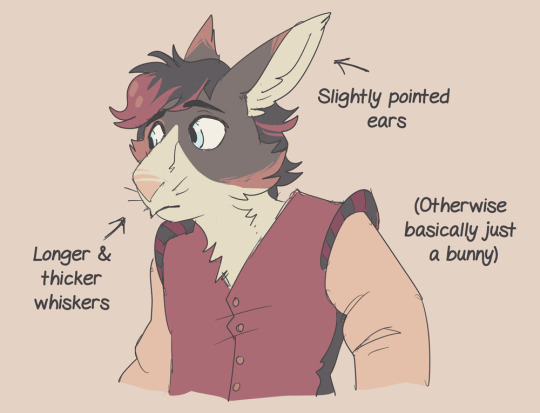
Typically, children will just inherit their species from one parent or the other. Hybridization is very unusual and typically is limited to one or two very minor traits--like the child of a rabbit having slightly longer ears, the child of a weasel having a noodlier build, the child of a carnivore having fangs, etc. In almost all cases, the dominant species of the child is very clear, and the hybrid traits tend to be very recessive--rarely preserved beyond one generation.
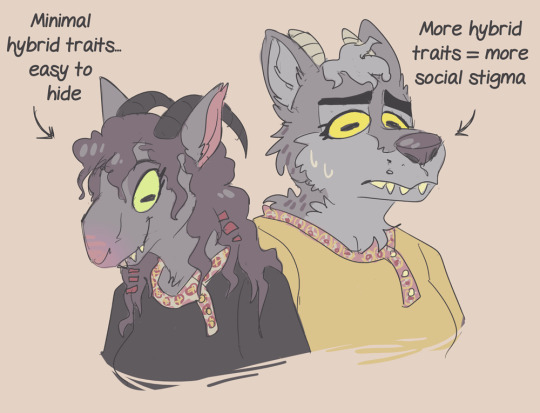
Particularly in the Western Kingdom, though, hybrid children do have a reputation for being unlucky, an ill omen, or even outright cursed (depending how superstitious the person you're asking is). There are a few reasons for this… the simplest is that hybrid traits are sort of a "birth defect" that can sometimes present along with other health issues. Though not all hybrids are frail and sickly, any concern about a child's susceptibility to illness was a huge deal in rural peasant villages that already tended to have high childhood mortality rates.
Over time, the perception of hybrid children = ill omen became warped and exaggerated. Western Kingdom folktales sometimes cast hybrids as vaguely supernatural trickster characters, such as tales of mysterious changeling babies whose hybrid traits eventually revealed them to be half Infernal.
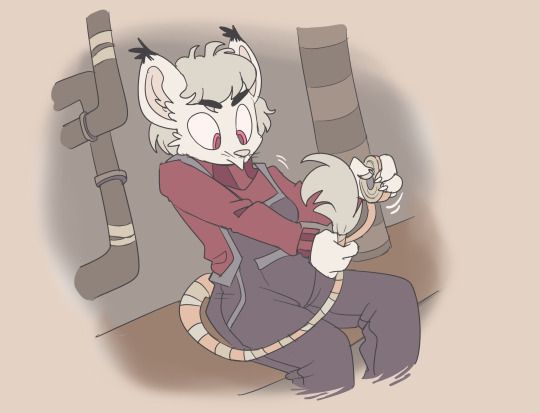
For this reason, the actual frequency of hybrid traits is probably greatly under reported… anyone who can hide or ignore or lie about their hybrid traits probably will. Though most Western Kingdom superstitions fell away after the collapse of the old kingdoms, some degree of stigma in Post-Fall society remains. No one seriously thinks a sheep with fangs is half Infernal anymore (most don't believe that Infernals and Celestials even exist), but it will still probably be passively assumed that a hybrid is less fit for difficult labor, among other things.
Half Celestial and Half Infernal offspring work a bit different… they're always technically "hybrids", but specifically hybridize in such a way that they take the form of mythological creatures (unicorn, dragon, cockatrice, etc). I'll let Kwillow talk more about this when she discusses Ambroys' mother since she's been the one working on this section of the lore, but Half Celestials are most certainly seen as a blessing. Half Infernals… well, fear of them is part of the reason hybrids are stigmatized in the first place, so suffice to say they have it rather rough. How severe the stigma is varies across cultures and tends to be worse in the rural West, better in cities, and pretty much completely absent in much of the Eastern Kingdom.
In the Post-Fall present day, nobody believes Celestials, Infernals, or their offspring exist anymore... aside from those who know about The Kingdom of the Sun.
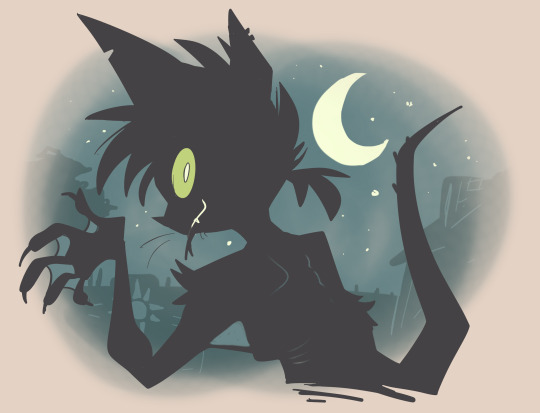
Also, once in a while, a hybrid is born whose traits are so blended that their parent species are difficult to determine. These very unlucky individuals are referred to as "chimeras" and tend to have shorter life expectancies, among other things. We may be seeing a character who fits this description eventually. :P
#I wrote up a whole thing for this and then Tumblr deleted it and I was so annoyed it took another month before I felt like rewriting it#I still think the old version that Tumblr bugged out and erased was better#ah well#furry#worldbuilding#furry worldbuilding#verse: amaranthine#wow the new post editor really doesn't play nice with read more does it
228 notes
·
View notes
Note
Hello
Long time follower. Big fan.
Umm i dont have any "real" friends and i feel like i have to vent about what happened to me with someone so plz bare with me.
Yesterday I was sexually assaulted. Outside my own apartment building by a man that is an "aquaintance" at most. I managed to get away by stepping on his foot and elbowing him in the stomach before it went any further. What sucks even more is that I live in a super conservative middle eastern country that has a society that loves to victim blame. I cant even go to the police cuz i have no proof and the sad thing is this the THIRD time in my life of 30 years where i get sexually assaulted. The first time was my cousin when I was 13 and the second time was someone who was a close friend when i was in my 20s. I feel pathetic and cowardly for not speaking up every time it happened. I know I cant tell my family cuz they are religious and all they care about is my "chastity" whatever the fuck that is and i honestly dont know what to do anymore.
Thank you for listening
🪽
hey angel,
i’m so sorry it took me a minute to see this, and honestly, i'm just fkn enraged that you're even in this position to begin with. none of this should’ve ever happened to you, and it’s so beyond messed up that you’ve had to go through it, and more than once, on top of everything else. first, i just want to say that i’m so, so grateful to you for opening up about it, especially when you’re feeling so isolated. it takes so much courage to even put this into words, and i’m honored that you trust me with it at all tbh. as much of an eye roll it is to hear, you’re truly not alone in this. and you’re definitely not “pathetic” or “cowardly” for how things played out or for not feeling like you could speak up before. the way you’re feeling is real, valid, and so understandable—especially when support and safety feel so distant.
it’s beyond unfair to be in a place where victim-blaming is such a huge part of the culture. to have to carry that, while being made to feel like you have to hide this, is an awful weight. but please know, this is not on you—none of it. the guilt and shame that the world tries to put on you is not yours, even if sometimes that feels impossible to believe. grounding yourself in the truth—that you haven’t done anything wrong, no matter how often you have to remind yourself—can be a solid step. and if you believe that for other people who've been in your shoes, then you must believe it for yourself too. ultimately, the shame belongs to the people who assaulted you and a world that hasn’t supported you the way you deserve. please don’t let their actions shape how you see yourself. your survival, your resilience, your courage etc that’s who you are.
there are a few places that might be able to give you some support, even if it’s from a distance. rainn.org offers confidential chat options and resources, and while it’s u.s.-based, it could still be useful if you need a safe space to talk. another is pandora’s project, a support and forum site specifically for survivors. they have spaces where people from all backgrounds, including those with similar cultural challenges, can connect. <3
if you’re open to it, a counselor or therapist who specializes in trauma and works online might be a good option, too. there are so many who understand the importance of privacy and safety in environments where speaking out can be challenging. the International Association for Trauma Professionals has a directory that could help you find someone who’d really get where you’re coming from and respect those unique challenges.
just remember, it’s okay to take this one step at a time. if all you can do today is share this with someone who cares, or offer yourself some compassion and grace to cry and breathe and be pissed and hurt and numb and upset, then that’s more than enough. i believe in your right to feel safe, supported, and heard, and there are people who genuinely want to help you get there, however and whenever you need.
sending you so much love and strength <3 if you need to vent or if you just need someone to talk to, please msg me any time. i understand what it's like to have your boundaries violated too and i know how lonely and painful it is to contend with it in your own head. x
33 notes
·
View notes
Note
What are some mythological monsters from Siren? Are any of them actually real? 👀 (some visual references appreciated if you're able...)
i was going to save this to draw something but don't think i'll have the time to work on it
some mythological monsters (really limited list tbh you can imagine that almost every community has their own take)
false phocid/doppelganger/mirror self/etc - this creature can be glimpsed at a distance and appears very similar to you, baby phocid, but you must never swim out to greet them. the mirror self will only swim further and further away, tempting you to follow, until it traps you in unfamiliar territory or even an evil maze, a place that resembles no place you've ever been before. moral of the story: don't trust strangers/teaching basic fear of the unknown
Tel!am - this is more of a godlike being than most mythological monsters, and can be found in the stories of people from the southern hemisphere. Tel!am is the seafloor itself, which is why deadly aerated water, which seeps up from cracks in the seafloor, is known as Tel!am's Blood/Breath/etc. Tel!am is asleep most of the time but wakes during rare high tide events, during which they rage against the moons and smash up any land/infrastructure/people that happen to get in their way. moral of the story: if there's a high tide forecast you need to get the fuck out of there
Odr - kind of an inverse of Tel!am, supposedly Odr was a giant selkie from the northern hemisphere who took on various heroic challenges to prove their might. They shaped much of the ice-caps by fighting monsters and enemies there (every stroke of their fighting spear would carve a new mountain or whatever, that kind of tale) before growing so sleepy that they curled up and fell into a slumber at a point in the icecaps now known as Odr's Sleep, became buried in snow, and is now only exposed during low tide events. the world as we know it will probably end if the tide gets low enough to reveal Odr entirely, causing them to wake. moral of the story: if there's a low tide forecast you need to get the fuck out of there
Kin/Ruler of the High Tide/Ishmael - in the western continent it is believed that there is a common ancestor for all phocids who arose from this region and that's how we got phocids, who were born when this ancestor raised a high tide. which is straightforward enough. but as people spread further and further from the western continent and settled more remote places, the legend grew legs and kind of morphed into 101 different cautionary tales about a morally-neutral trickster character who, again, might end the world if he raises another high tide, or might birth a new generation of sirenians. moral of the story: you guys should be writing your history down better probably
The Endless Kattakati - this one comes from zetas in the eastern continent. In the past it was common for zeta packs of up to twenty individuals to all be in one kattakati (i.e all of them were considered to be One Single Entity, like a culturally eusocial rather than biologically). there are surviving stories of a potential future, like a different fork in the path of history, that resulted in every single zeta being in ONE kattakati. a single person with tens of thousands of bodies. whether or not this idea is a comfort to them varies of course; the more traditionally-minded might think it sounds very peaceful, while those more integrated with outside cultures and people might see it as a frightening tale of assimilation and loss of individuality. some say that it could happen in the future, too, if only they could sum up the will to try. moral of the story: peace and community are within reach if only we set aside our differences more/oh god oh no oh fuck
longwing visors in general - with each one being tied to a specific character, some of them do happen to be monstrous in nature. flying monsters are a common theme - usually based on recreations of the large, winged metal caskets in which many visors were first unearthed. these creatures were said to plague the first generations of longwings, ruling the skies and attacking anything around them, until mysteriously they all died, transferring their powers of long-distance communication and foresight into the visors inside their bodies. moral of the story: sorry you got stuck with a visor with monstrous baggage i guess you're kind of a monster now too
the Night-time Professor - if you join the university at the Spire as a new student you might hear stories of a strange apparition that flies through the hallways and lecture rooms at night. that's actually a ghost of a scholar who got sick and died while working on his thesis, but that's no fucking excuse for not turning your work in on time so he's STILL out there working on it and won't be allowed to pass on until he's finished. moral of the story: we don't accept sick notes and you're not getting that deadline extension
77 notes
·
View notes